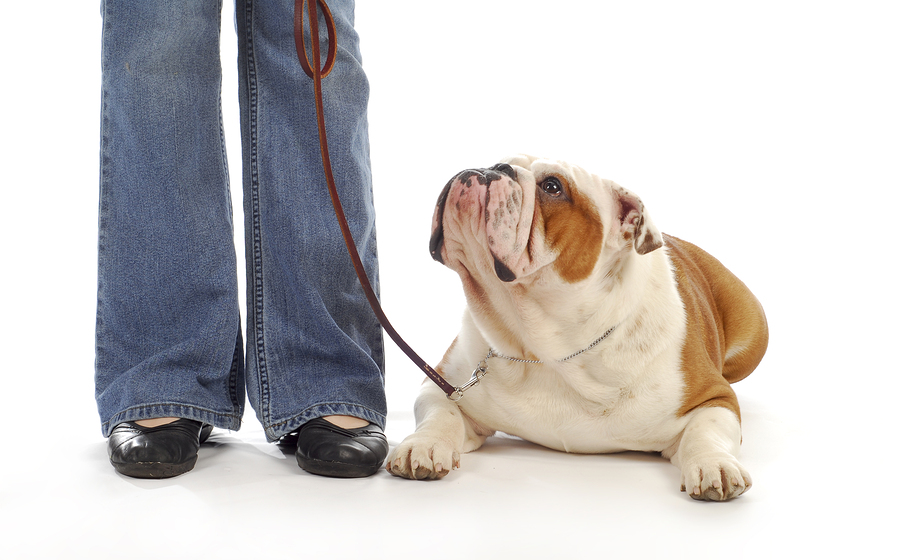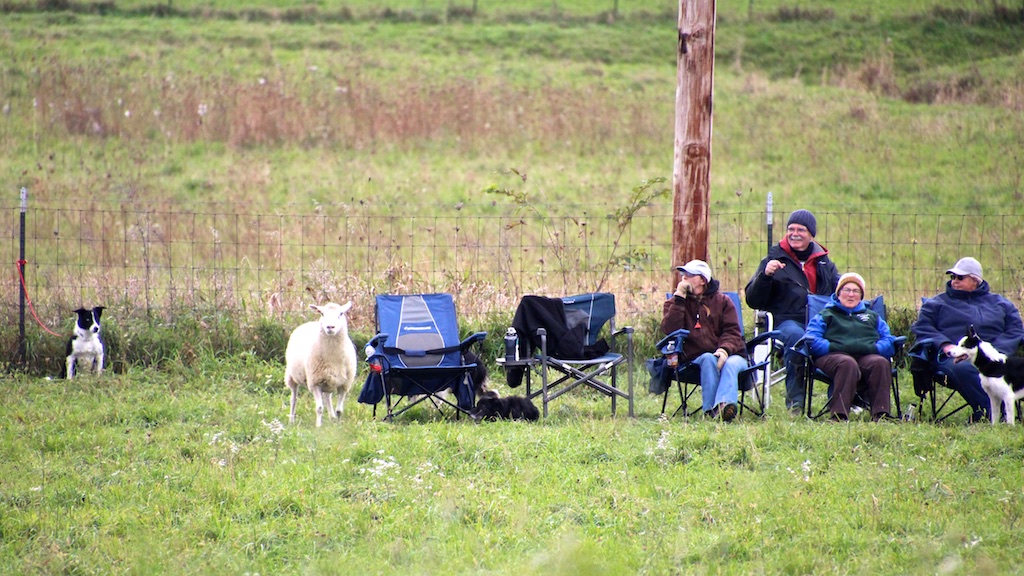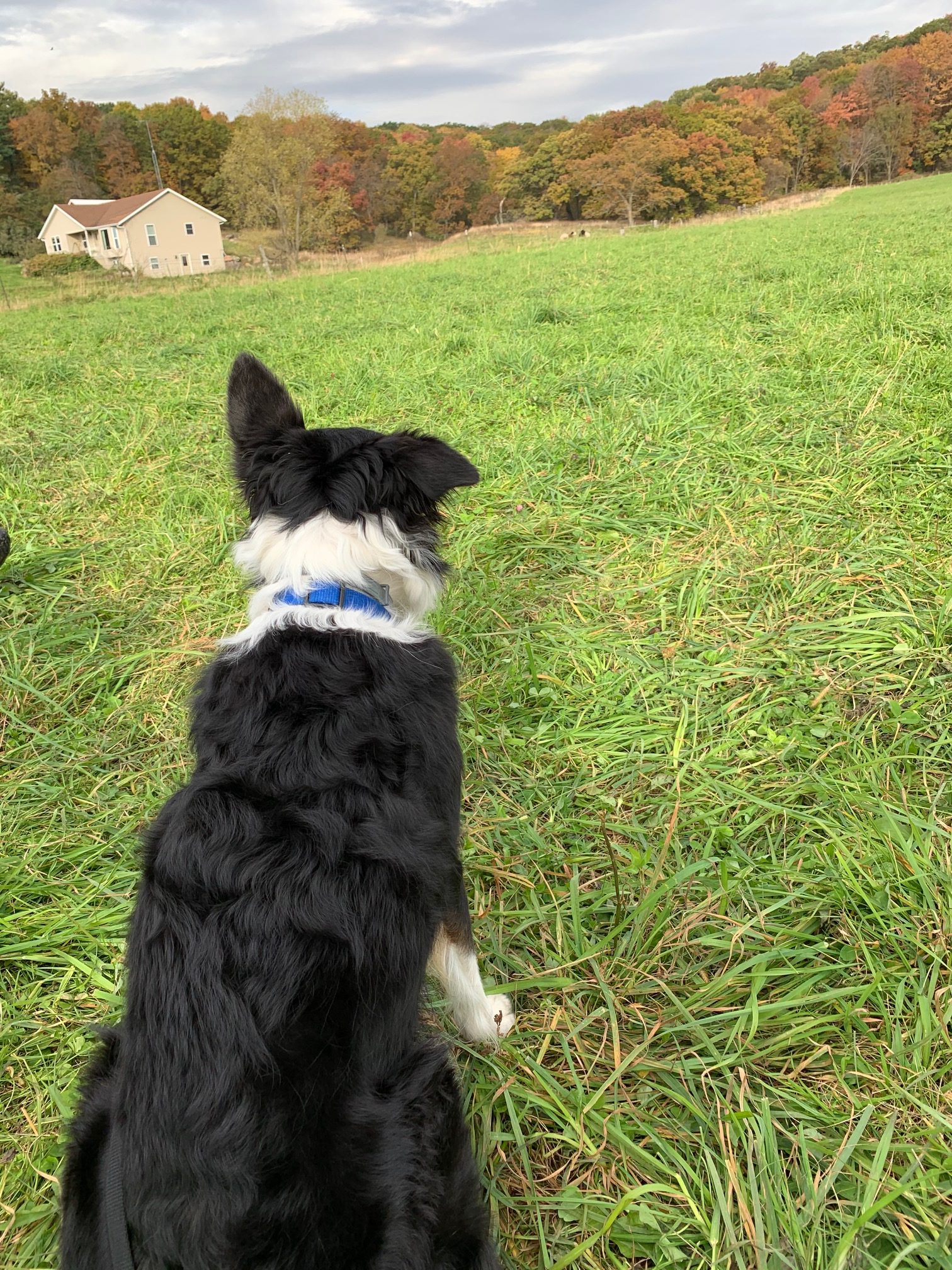The Challenge of Pet Dog Training
A top handler said, after Maggie and I had had a rough run at a sheepdog trial last month, “You’re in good company, this is hardest thing I’ve ever done”. Bless them for their compassion. I’ve probably heard that ten times this summer, from people who in their other lives are accomplished professionals who work challenging jobs. Doing well at the highest level of a sheepdog competition is indeed a challenge–the number of factors that influence each and every one of your split-second decisions are endless.
That said, I want to take a moment to look at pet dog training, and give a shout out to everyone who does it, both personally and professionally. The fact is that it has its challenges too, the primary one being that we are “training” our companion dogs every second of the day that we are with them. Whether we call it training or not, our dogs are learning every moment that we are with them. For many of us, that includes when we are in a rush in the morning, stressed about the meeting that we are already late for, and when we are sprawled on the couch, exhausted from a long day and wanting nothing more than to cuddle with Smudges or Sushi and stroke her belly until our ridiculous, escapist television show is over.
Dogs who live in kennels and only come out for training are primed to pay attention to everything their human says or does. They have no opportunity to learn bad habits, and to discover how incredibly inconsistent humans inherently are. But I love having my dogs in the house with me, even though I want working, competition dogs who listen to every nuanced signal I send at a competition. I think all of us, no matter what we do with our dogs, want them trained well enough to listen and respond when we need them to.
So how do we handle the fact that it’s impossible to be “on” all the time when we’re at home? To need to be consistent when we inherently are not? Here are a few thoughts; I am looking forward to other good ideas from you.
Mostly importantly, make a choice: Decide what two or three cues are critical, and focus on being consistent with them. For example, any Border Collie who lives here at the farm has to be 100% responsive when I say Lie Down, and when I call them back to me. Otherwise, it would not be safe to let them off leash anywhere, in the front yard where we play every morning, on walks in the woods, at sheepdog clinics and competitions. Those contexts are essential to our quality of life, and so those cues are the most critical.
You’d think just two cues would be easy to use consistently, but I find that it’s easy to jumble things up. For example, Maggie’s recall is “Pup Pup”, but I began using “Here” after I started teaching her to shed. “Here” means “Come in toward me and then focus on the sheep that I’m facing and drive then away from the others”. Although “Pup Pup” and “Here” have similar meanings–come to me–they are used in such different contexts that I am wise to keep them apart. But recently I noticed that Jim and I were both saying “Here” just to call her to come when out and about. Not a crisis, but not ideal.
And of course, there’s the seductive desire to use a variety of other words in place of one, single recall signal. My biggest pet peeve (Ha! And yes, I did mean that pun.) is a dog’s name being used to mean, well, just about anything. If I’ve said “Maggie, what?” to Jim once, I’ve said it a thousand times. But the jokes on me, because sometimes I do it too–say a dog’s name with no more information to follow. If a dog’s name is to get their attention, then you need to follow it up with what you want your dog to do. “Read my mind” is not a reasonable expectation.
Being consistent is anathema to being human; that’s why we need to work so hard on it. It’s especially difficult if you live with several others. That’s part of why I suggest focusing on just a few cues that are essential. It’s hard enough to work on yourself, but even harder to get everyone else in the house to work on too. Especially if you’re the one who feels its importance. A lot of my clients had success with a family conference, agreeing on 2 or 3 cues that are essential and how they were going to say and use them consistently. Perhaps most importantly, you might figure out a positive reinforcement scheme to reward your family for playing the game. Guard against nagging, the bug-a-boo of all training paradigms, and the easiest trap to fall into. (Reinforce yourself for reinforcing!)
Last advice: Let it go. If it’s not in the Essential category, and you or your family uses it inconsistently, let it go. At least while you work on the others. In spite of my argument that we need to be consistent ourselves to get consistent results, dogs can understand contexts, and learn to not jump up on you, while leaping into your husband’s arms every night when he comes home. They can learn the couch is fair game when you’re home, but not when company comes. But, of course, it’s harder for them to figure out the context, so be thoughtful about where you draw the line.
I could go on forever about this topic, but I’m curious about you–if you had to pick 2-3 cues that are most essential for you and you family to work on, what would they be? How consistent are you, and with what cues? How about the rest of the family? I can’t wait to read what you have to say.
MEANWHILE, back on the farm: Just back from a fabulous three-day sheepdog training clinic with Patrick Shannahan. I am confident in saying that Maggie’s brain is as full as mine; lots of great information to process. At one point I thought both our heads would explode when what Maggie and I thought was a perfect, PERFECT fetch was, uh, not. Maggie was bringing the sheep on a straight line to me, even though they desperately wanted to run to the right back to their buddies. What could be wrong with that? But I quickly got Patrick’s point that she was using her body, or her physical presence to keep them in line, when she should have been using just her eye. If the sheep were in the center of a clock face and I was at 6:00, Maggie was at about 2:30. If she’d been just a hair over to the left, around 2:15, she would have had a better hold of them by using the power of her eye rather than the presence of her body.
I totally get the theory. However, the reality will be a challenge. Teaching Maggie to scooch over just a few inches (too many inches over, and she’d lose them when they take off in a dead run to the others) is going to take some work. And faith on my part that Maggie will figure it out and work through the confusion. Patrick was clear–if you want to learn to be an advanced handler, that’s the kind of distinction you need to be able to make. Well, we have all winter to work on it, lucky us. And I can’t wait to get started.
Overall it was a glorious weekend–Maggie and I will be processing what we learned for a long time to come, the weather was nippy but accommodating, our host–Thank you Laura!–kept everything running smoothly and fed us like royalty, and there was lots of time to talk and laugh with good friends. Now that Maggie is older, she is able to lie quietly at my feet and watch everyone else’s session, so we spent almost all three days outside, together and loving our life. Lucky us.
A few photos:
You can almost feel the sheep’s desire to go to the right (their left) in this photo of Maggie fetching the sheep to me. (Thank you Julie for taking the photo!)
Here’s a shot of the area where we spent all of Friday, Saturday and Sunday. Life is good when you get to look at this for three days running!
It did mean getting up pretty early every morning to drive to the clinic. But I got lots of reinforcement for it even before we got to the clinic site:
This ewe decided she’d rather spectate than work. Fit right in.
Maggie says thank you to Patrick Shannahan and Laura W for such a wonderful, informative clinic!











Post a Comment